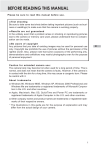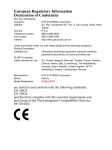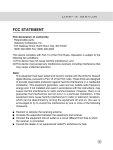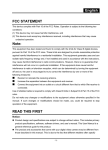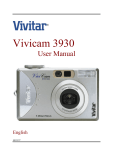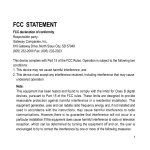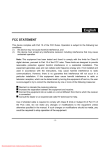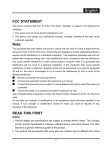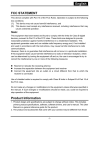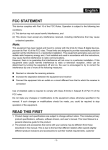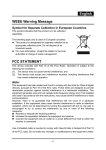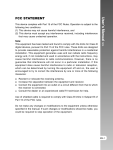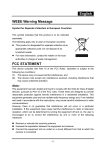Download English FCC STATEMENT READ THIS FIRST
Transcript
English FCC STATEMENT This device complies with Part 15 of the FCC Rules. Operation is subject to the following two conditions: (1) This device may not cause harmful interference, and (2) This device must accept any interference received, including interference that may cause undesired operation. Note: This equipment has been tested and found to comply with the limits for Class B digital devices, pursuant to Part 15 of the FCC rules. These limits are designed to provide reasonable protection against harmful interference in a residential installation. This equipment generates uses and can radiate radio frequency energy and, if not installed and used in accordance with the instructions, may cause harmful interference to radio communications. However, there is no guarantee that interference will not occur in a particular installation. If this equipment does cause harmful interference to radio or television reception, which can be determined by turning the equipment off and on, the user is encouraged to try to correct the interference by one or more of the following measures: Reorient or relocate the receiving antenna Increase the separation between the equipment and receiver Connect the equipment into an outlet on a circuit different from that to which the receiver is connected Consult the dealer or an experienced radio/TV technician for help Use of shielded cable is required to comply with Class B limits in Subpart B of Part 15 of the FCC rules. Do not make any changes or modifications to the equipment unless otherwise specified in the manual. If such changes or modifications should be made, you could be required to stop operation of the equipment. READ THIS FIRST 1. The bundled driver, software, design, specifications and user’s manual that were packaged with the camera are subject to change without notice. 2. The accessories that come with the camera may vary between regions. 3. For driver updates, you can check the “Download” section of our website, www.geniusnet.com.tw. -1- English 4. We are not liable whatsoever for any compensation arising from errors in descriptions in this user’s manual. WARNING Do not use the camera if it is emitting smoke, becomes unusually hot to be touched, emitting any unusual odor or noise, or if it is in any other abnormal state. Operating the camera in any of these situations may cause a fire or an electrical shock. Stop using the camera immediately, turn the camera off, and then disconnect the power source (batteries or AC power adapter). If you are using the AC power adapter, unplug the adapter from the AC power outlet after you have disconnected the camera. After checking that smoke is no longer being emitted, contact your dealer or a local authorized service facility and request repairs. Never attempt to repair the camera yourself, as this will terminate the warranty. Do not use the camera if any foreign objects have entered the camera. Turn the camera off, and disconnect the power source (batteries or AC power adapter). If you are using the AC power adapter, unplug the adapter from the AC power outlet after you have disconnected the camera. Then contact your dealer or a local authorized service facility. Do not continue to use the camera as this may cause a fire or an electrical shock. If the camera has been dropped or if the camera case has been damaged, turn the camera off, and then disconnect the power source (batteries or AC power adapter).If you are using the AC power adapter, unplug the adapter from the AC power outlet after you have disconnected the camera. Then contact your dealer or a local authorized service facility. Do not continue to use the camera as this may cause a fire or an electrical shock. Do not place the camera in any unstable locations such as on a wobbly table or sloping surface where the camera may fall or tip over and cause injury. Do not expose the camera to moisture and make sure that there is no water getting into the camera. Take particular care when using the camera under extreme weather conditions such as rain or snow, or when operating the camera at the beach on near water. Water in the camera may cause a fire or an electrical shock. Do not attempt to modify the camera. This may cause a fire or an electrical shock. Do not remove the camera casing. This may cause an electrical shock. Your dealer should only carry out internal inspection, maintenance and repairs or a local authorized service facility. Do not touch the power plug during a thunderstorm if you are using the AC power adapter. This may cause an electrical shock. -2- English CAUTION Do not place the camera in damp or dusty locations. This may cause a fire or an electrical shock. Do not place the camera in a location affected by oil fumes or steam, such as near a cooking stove or humidifier. This may cause a fire or an electrical shock. Do not cover or wrap the camera or the AC power adapter with a cloth or quilt. This may cause heat to build up and distort the case and cause a fire. Always use the camera and its accessories in well-ventilated locations. Handle the camera carefully and do not bump the camera into any hard object. Handling the camera roughly may cause a malfunction. Do not move the camera while it is switched on. (If you are using the AC power adapter, unplug the adapter from the AC power outlet after you have switched off the camera.) Ensure that any connector cords or cables to other devices are disconnected before moving the camera. Failure to do so may damage the cords or cables and cause a fire or an electrical shock. When leaving the camera unused for long periods, such as during a vacation, always remove the batteries from the camera or unplug it from the power source (AC power adapter) for safety. If you are using the AC power adapter, unplug the adapter from the AC power outlet after you have disconnected the camera. Failure to do so could result in a fire. Do not use batteries other than those specified for use with the camera. The use of unsuitable batteries may result in the batteries splitting or leaking and causing a fire, injury, or soiling of the battery compartment. When placing the batteries into the camera, check the polarity markings on the battery (and +) to ensure that you insert the battery correctly. Incorrect battery polarity may result in the batteries splitting or leaking and causing a fire, injury, or soiling of the battery compartment. Remove the batteries if the camera will not be used for an extended period of time. The batteries may leak and cause a fire, injury or soiling of the battery compartment. If the batteries leak, clean and wipe the battery compartment carefully and install new batteries. Wash your hands carefully if you touch the battery fluid. -3- English CONTENTS INTRODUCTION 6-7 Speed-priority Mode Overview Package contents Optional Accessories Photography in the Aperture-priority Mode Photography in the Full Manual GETTING TO KNOW THE CAMERA Mode 8-13 Photography in the Portrait Mode Front view Rear view Mode dial Viewfinder LED indicators LCD monitor information GETTING STARTED Photography in the Sports Mode Photography in Night Scene Mode Making Movie CHANGING THE PRESET 14-16 CONDITIONS Installing the batteries Charging the Battery Inserting an SD memory card Attaching the strap (IN CAPTURE MODE) Picture setting Size TAKING PHOTOGRAPHS Quality 16-28 Sharpness Photography in the Auto Capture Contrast Mode Using the Viewfinder Using the LCD Monitor LCD Monitor Display (Capture Mode) Using the Optical Zoom Using the Digital Zoom Using the Self-timer Using the Flash Changing the Focus Changing the Exposure Compensation Setting the Image Size and Quality Color Function setting Capture Mode Voice Memo LCD Brightness Digital Zoom Preview Interval/Count AE/AWB setting Photography in the Program Mode White Balance Photography in the Shutter Metering ISO -4- 29-35 English Auto Power Off Custom Setting Date/Time System Reset Language Video Output System Information Manual WB PLAYING BACK IMAGES 35-42 Playing Back Photographed images (Single-Frame Playback) Voice Record Playing Back Movies Thumbnail Display Zoom Playback Slideshow Display DPOF (Digital Print Order Format) Protect LCD Brightness LCD Monitor Display (Playback Mode) ERASING IMAGES TRANSFERRING RECORDED IMAGES/MOVIES TO YOUR COMPUTER 42-43 INSTALLING Erasing Single Image Erasing All Images Erasing Selected Image SET-UP MODE 47-50 Step 1: Installing the USB Driver Step 2: Connecting the Camera to Your Computer Step 3: Downloading Images/Movies PHOTOSUITE 50 INSTALLING PHOTOVISTA 43-47 51 CONNECTING THE Basic Setting Card Information Frame Number Reset Format Sound Beep CAMERA TO OTHER DEVICES 52 CAMERA SPECIFICATIONS -5- 52-53 English INTRODUCTION Overview Your new digital camera delivers high quality, 2560 x 1920 resolution images using a 5.25 Mega pixels CCD imager. Using either the optical viewfinder or the 1.5” TFT color image LCD monitor, you can compose images and then examine them in detail. An auto-flash sensor automatically detects the shooting (lighting) conditions and determines whether the flash should be used. This feature helps ensure that your images turn out right. SD Memory Card is storage medium for saving images that you have photographed. Even if the camera’s power is turned OFF, the images saved on the SD Memory Card are not erased. SD Memory Card can be repeated read and written. Images you have taken can be downloaded to your computer using the USB cable (USB driver required for Win 98 and Mac OS 8.6). You can enhance and retouch your images on your computer by using the provided editing software, or image editing software you may have already owned. You may share your images with your friends via e-mail, in a report, or on a website. DPOF functionality allows you to print your images on a DPOF compatible printer by simply inserting the memory card. Note: The memory card testing results for 512MB are based on Toshiba, Panasonic and Sandisk SD Memory Card. Package contents Carefully unpack your package and make sure that you have the following items. In the event that any item is missing or if you find any mismatch or damage, promptly contact your dealer. Digital camera USB cable Video cable Software CD-ROM User’s manual Camera strap -6- English Quick guide Camera pouch Two Rechargeable Lithium Ion A 32MB SD memory card Batteries Rechargeable Lithium Ion Battery Rechargeable Lithium Ion Battery Charger Charger Power Cord AC Plug Adaptor for EU to US Note: Accessory and components may vary by different retailer. -7- English GETTING TO KNOW THE CAMERA Front view 1. 2. 3. 4. 5. 6. 7. 8. 9. 10. Self-timer/AF support LED Optical viewfinder Built-in flash Shutter button Lens/lens cover POWER Power button MIC Microphone Mode dial DC IN 5V terminal USB/A/V OUT terminal -8- English Rear view 1. Diopter adjustment dial 2. Viewfinder 3. Viewfinder LED 4. 5. Arrow button (up) 1. / Focus button/macro Arrow button (left) 2. Zoom button Speaker 6. Menu button 7. Display button Exp./back light 8. Strap attachment 3. Set button 9. Command dial 4. Arrow button (right) 10. Flash button 11. Tripod socket 12. Battery/SD Memory Card cover 13. LCD monitor / 5. Arrow button (down) Self-time button/interval -9- Delete button English Mode Dial 1. 2. Auto Program mode 7. 8. Sports mode Night scene mode 3. Tv (Shutter Speed priority) 9. Movie mode 4. Av (Aperture priority) 10. Set-up mode 5. Manual mode 11. PC mode 6. Portrait mode 12. Playback mode -10- English Viewfinder LED Indicator Description Color Green State On On Red Flashing On Orange Flashing Photography Mode Setup Mode Charge Mode PC Mode Battery AE or AF is locked with the Shutter button held half down. In standby mode. In communication to PC. (SD Memory Card is inserted.) Under charging Writing to SD Memory Card in progress. Accessing of SD Memory Card in progress In connecting to PC. (SD Memory Card is inserted.) Error When the image is not in focus. ─ Processing images Charging of flash in progress ─ Disconnection (SD Memory Card is inserted.) Hardware malfunction -11- SD Memory Card is not inserted. Interval timer standing by No battery ─ English LCD Monitor Information AUTO capture mode Program/Tv/Av/Manual/Portrait/Sports/Night scene mode -12- English Movie mode Playback mode (Standard) Playback mode (Detailed information) -13- English GETTING STARTED Installing the Battery 1. 2. 3. 4. Make sure the camera power is off. Open the battery/SD Memory Card cover. Insert the battery in the correct orientation shown. Tilt the battery lock lever toward the strap attachment and then insert the battery following the orientation of the arrow on the battery’s label. Insert the battery as far as it can go. Close the battery/SD Memory Card cover. To remove the battery: Open the battery/SD Memory Card cover and then release the battery lock lever. After the battery is slightly ejected, pull out the battery slowly. NOTE Use only the specified battery type (Lithium Ion). If you are not going to use the battery for an extended period of time, remove it from the camera to prevent leakage or corrosion. Never use different type of battery. Avoid using battery in extremely cold environments as low temperatures can shorten the battery life and reduce the camera performance. Charging the Battery LED INDICATION AC INPUT -14- English 1. 2. 3. Insert the battery, noting correct polarity (+ and -). Input Voltage:100-240V/50-60Hz Output Voltage:4.2V/750mA LED Indicator: Status Battery not installed Battery installed Battery installed Battery installed/not installed LED Indication Green Green Red Battery Charge Condition OK Fully charged Charging Off Battery/charger defective Notice: A. Before you use a new battery, it should be charged for 3 hours the first time. B. If the green LED is on when power is connected, it indicates the battery charger is operating normally and ready for battery charging. C. When the battery is put into the battery charger, the LED indicator changes from green to red, indicating the battery is being charged. D. If the LED indicator is not on when the power is connected, it indicates that the battery charger is defective. The user should turn AC power off. E. If the battery has been charged over 3 hours and the LED indicator is still red, this means the battery is faulty. The user should remove the battery. F. If it is necessary to charge a backup battery, the user should wait until the charging battery is completely charged. Then remove the charged battery and charge the backup battery. NOTE Never use the battery unspecified for the camera. Do not place the camera in hot temperature. Use it at room temperature. Inserting an SD Memory Card (Optional) All images and video clips taken by the camera can be stored in an SD (Secure Digital) Memory Card. Even if the camera’s power is OFF, the images saved in the SD Memory Card are not erased. An SD Memory Card can be repeated read and written. You may also expand the memory capacity up to 512MB so that you can store additional images and video clips. 1. Make sure the camera is off. 2. Slide the battery/SD Memory Card cover in the direction of the [OPEN] arrow. 3. Insert an SD Memory Card : The front side of the memory card (printed arrow) should face towards the front side of the camera. If the card cannot be inserted, check the orientation. 4. Close the battery/SD Memory Card cover. To remove the SD Memory Card, make sure the camera is off. Open the battery/SD Memory Card cover. Press lightly on the edge of the memory card and it will eject. -15- English NOTE If the camera is powered-on without the card, the “NO CARD” message appears on the LCD monitor. To prevent valuable data from being accidentally erased from an SD Memory Card you can slide the write-protected tab (on the side of the SD Memory Card) to “LOCK”. To save, edit or erase data on an SD Memory Card, you must unlock the card. MMC Card can not be accepted to use. Please format an SD Memory Card by this camera before use. Attaching the Strap To prevent accidental slippage during the use, always use the strap. Attach the hand strap as follows: 1. Thread the small loop of the hand strap through the strap eyelet 2. Pull the large loop through the small loop until the strap is firmly on the camera. secured. TAKING PHOTOGRAPHS Photography in the Auto Capture Mode [ Your camera provides a single image capturing, continuous image capturing and auto exposure bracketing capturing. It is equipped with both an optical viewfinder and a 1. 5” full color TFT LCD monitor to compose images. Taking images by using the optical viewfinder will conserve more battery power. If your battery is in low level, it is recommended to compose images by using the viewfinder. The LCD monitor can help you accurately compose the pictures and examine all details. However, this may also consume you more battery power. -16- ] English Using the Viewfinder 1. Turn the camera on by pressing the POWER button. ]. 2. Set the mode dial to [ 3. Compose your shot in the viewfinder. Turn the “diopter adjustment dial” until the image appears clearly within the viewfinder. 4. Press the shutter button down halfway, and then press it down fully. The viewfinder LED indicator lights red while the camera is processing a captured image. NOTE Voice memo is starting to record at still image capture mode just after the photograph is taken in case of activating this function. It provides 10 seconds for recording and only can be done once. To terminate recording, press the shutter button down fully. Using the LCD Monitor 1. Turn the camera on by pressing the POWER button. 2. Set the mode dial to [ ]. By default, the LCD monitor setting is "ON". 3. Compose the picture in the LCD monitor. 4. Press the shutter button down halfway (the camera adjusts the exposure and the focus), then press it down fully. The viewfinder LED indicator lights red while the camera is processing a captured image. LCD Monitor Display (Capture Mode) The [ ] Display button can select display format. Whether in “Still Image” or “Movie” mode, preview image with full OSD is displayed. OSD (on-screen-display) full display OSD display OFF -17- LCD monitor OFF English NOTE The image in the LCD monitor darkens in strong sunlight or bright light. This is not a malfunction. Using the LCD monitor for an extended period of time will decrease the number of images you can take. To increase the shots and conserve battery power, it is recommended to turn the LCD monitor off and use the viewfinder instead. Using the Optical Zoom The lens moves during the zoom photography. Zoom photography allows you to take telephoto and wide-angle shots. The subject appears closer by pressing the [ farther away by pressing the [ ] button. 1. Set the mode dial to one of [ 2. power on the camera. If required, turn on the LCD monitor by pressing the [ 3. ] button and appears ], [ ], [ ], [ ], [ ], [ ], [ ], [ ], [ ] and ] button. Compose the picture by using the [ ]/[ ] button. Pressing the [ ] button zooms in on the subject, and enlarges the subject on the LCD monitor. Pressing the [ 4. ] button provides a wider angle picture. The lens position moves according to the zoom button setting. Press the shutter button down halfway, and then press it down fully. Using the Digital Zoom By using the digital zoom, images can be enlarged so that the subject appears closer. However, the more the image is enlarged, the grainer the image will become. The digital zoom function is only available when you set the LCD monitor and the digital zoom to ON. To capture a digitally zoomed image, perform the following steps: 1. Set the mode dial to one of [ 2. power on the camera. If required, turn on the LCD monitor by pressing 3. To enable the digital zoom is as follows: the [ ], [ ], [ ], [ ] button. -18- ], [ ], [ ], [ ], [ ], [ ] and English 4. a. Press the MENU button. b. Press the or button to select Function page. c. Press the or button to select Digital Zoom, and press the SET button. or button again to select ON, and press the SET button. d. Press the e. Press the MENU button. f. To activate the digital zoom, press the [ ] button completely and hold it until the image on the LCD monitor expands. Press the shutter button to capture a “zoomed” image. NOTE The camera has 1X to 3X optical zoom and 1X to 4.0X electrical zoom function. Digital zoom function is terminated when user selects LCD off mode. Using the Self-timer The [ ] self-timer button can select the capturing mode between “OFF” (default) and “Self timer (2 sec., 10 sec., 10+2 sec. or Interval)”. [2 sec.] The camera automatically takes a picture after two seconds delay. [10 sec.] The camera automatically takes a picture after ten seconds delay. [10+2 sec.] The camera automatically takes a picture after ten seconds delay, and takes again after two seconds. In case of flash light capacitor is not charged up, the second take can be done at two second after charged. [Interval] The camera automatically takes a picture every preset time till media full or battery empty. To activate the self-timer by pressing the shutter button. After selecting this mode, self-timer icon displays on LCD monitor and then LED on the front panel blinks fast for the last 3 seconds. Using the self-timer allows you to get into the scene when taking group images. 1. Secure the camera to a tripod or place it on a stable surface. 2. Set the mode dial to one of [ ], [ ], [ ], [ -19- ], [ ], English [ 3. ], [ ], [ Press the [ ], [ ] and power on the camera. ] button. When you toggle the self-timer button, the following are displayed in the accordingly order: Off 4. 5. 10 sec 2 sec 10+2sec Interval Compose the picture. Press the shutter button down halfway, and then press it down fully. The self-timer function is activated. The photograph is then taken after the preset time. When the photographs are taken using the LCD monitor, the count down is displayed. NOTE After an image is taken using self-timer, the self-timer mode is turned off. The self-timer is not possible in the continuous capture mode. The self-timer is only available for 2 or 10 seconds delay at [ ] mode. The camera automatically starts to recording after 2 or 10 seconds. Using the Flash The flash is designed to function automatically when lighting conditions warrant the use of flash. You can take an image using a suitable flash mode to your circumstances. If you change the flash mode, the camera will retain that setting even if the camera is turned off. ], [ ], [ ], [ ], [ ] and power on the camera. 1. Set the mode dial to one of [ 2. Press the [ ] button repeatedly until your desired flash mode appears. ] mode, the available flash modes are When you toggle the flash button at [ displayed in the following order. Red-Eye Forced Flash [ No display ] Auto [ 3. ] Suppressed Flash [ ] Forced Flash Compose the picture and press the shutter button down halfway, then press it down fully. NOTE -20- English After flash fires, it takes approximately 5 seconds to 10 seconds to be ready for the next shot during solid orange indicator. The camera has FOUR flash modes: Auto, Red-Eye Reduction, Forced Flash and Flash Off. The table below will help you to choose the appropriate flash mode: Icon [ ] Flash Mode Description Auto Flash The flash fires automatically according to the ambient lighting conditions. Red-Eye Reduction (With auto-flash except to [Tv] [Av],[M]) Select this mode for general photography. The flash emits a precursor-flash before the main flash fires. This causes the pupil in the human eyes to contract, reducing the red-eye phenomenon. Select this mode when taking images of people and animals in low-light conditions. Forced Flash The flash will always fire regardless of the surrounding brightness. Select this mode for recording images with high contrast (back lighting) and deep shadows. Flash Off The flash will not fire. Select this mode when taking images in a place where flash photography is prohibited, or when the distance to the subject is beyond the effective range of the flash. NOTE Auto flash can only be set at [ ] mode. It can not be set at [M], [P], [Tv] and [Av] modes. In the [ In the [ ] Sports mode, flash setting is fixed to [ In the [ ] Night scene mode, flash setting is fixed to [ ] Portrait mode, flash setting is fixed to Red-Eye Reduction mode automatically. -21- ]. ] except [ ] Focus mode. English Changing the Focus 1. Set the mode dial to one of [ [ ], [ ], [ ], [ ], [ ], [ ], [ ], [ ], ] and power on the camera. 2. Toggle the Focus button. The selected focus mode is displayed on the LCD monitor. [no indication]: Normal Auto Focus (0.8m to infinity). Macro Auto Focus (0.09m to infinity/ Wide, 0.3m to infinity/Tele). The camera will focus on the subjects in a distance of infinity to take photos. The camera will focus on subjects in a distance of 3m to take photos. The camera will focus on subjects in a distance of 1m to take photos. 3. 4. Compose the picture. Press the shutter down halfway, and then press it down fully. NOTE When shooting a close-up in Macro mode, use the LCD monitor to compose your shot, avoiding the off-center parallax phenomenon. There is not a distinct point (subject range) at which Normal mode is favored over Macro mode; take in image in both optical modes and compare the results. After a Macro shot is taken DO NOT FORGET to reset the lens to the normal position. Changing the Exposure Compensation This setting allows you to intentionally lighten or darken the entire image. Use this setting when the optimum brightness (exposure) cannot be obtained, for example, when the brightness between the subject and the background is not balanced or when the subject to photograph occupies only an extremely small part of the screen. The Exposure Compensation button can select “Normal capturing mode”, “Backlight compensation capturing mode” and “Exposure compensation adjusting mode” cycling. 1. Set the mode dial to one of [P], [Tv], [Av] and power on the camera. -22- English 2. Toggle the 3. compensation mode. When exposure compensation mode is selected, rotate the Command dial to adjust the button to select exposure compensation mode or backlight exposure, and press the button again to confirm. Rotate the Command dial to counter clockwise direction to decrease (darken) exposure, and rotate the Command dial to clockwise direction to increase (brighten) exposure. Compose the picture, press the shutter button down halfway, and press it down fully. 4. Effective Subjects and Set Values Positive (+) Compensation • Copying of printed text (black characters on white paper) • Backlit portraits • Very bright scenes (such as snowfields) and highly reflective subjects • Shots made up predominantly of sky Negative (-) Compensation • Spot lit subjects, particularly against dark backgrounds • Copying of printed text (white characters on black paper) • Scenes with low reflectivity, such as shots of green or dark foliage -23- English NOTE While selecting “Backlight compensation capturing mode” , the EV value sets to +1.3 EV automatically and setting of exposure compensation value is ignored. In “Exposure compensation”, the default value is “0.0EV”. The setting range is as follows: -2.0 / -1.7 / -1.3 / -1.0 /- 0.7 / -0.3 / 0 (default) / +0.3 / +0.7/ +1.0 / +1.3 / +1.7 / +2.0 ] mode. Exposure Compensation cannot be set at [ The ideal brightness sometimes cannot be obtained even if a large exposure value is set in dark photographic conditions. In this case, press the shutter button, and check the brightness in the preview image (photographed still image). Setting the Image Size and Quality Size and quality settings determine the pixel size (dimension), image file size, and compression ratio for your image. These settings affect the number of images. These settings affect the number of images that can be stored in an SD Memory Card. Larger and higher quality images offer the best photographic results but take up more memory space. Larger/quality settings are recommended for printed output and situations requiring the finest detail. Smaller/quality images take up less memory space and may be quite suitable for sharing images via e-mail, in a report, or on a web page. To change image size or image quality, 1. 2. 3. 4. 5. ], [ Set the mode dial to one of [ ], [ ], [ ], [ ], [ ], [ ], [ ] and power on the camera. Press the MENU button. The menu screen appears. Select Size or Quality by using the or button. Press the SET button. Select the desired image size or image quality setting by using the or button. Press the SET button to confirm. To exit the menu screen press the MENU button. The tables below show the approximate number of images that can be stored on Still Image and Movie Image mode. Still Image Mode Quality mode (Compression Rate) Fine (1/4) Image Size 5M (2560 x 1920) 8MB 16MB 32MB 64MB 128MB 256MB 512MB 2 6 13 27 55 105 222 -24- English 3M (2048 x 1536) 1.2M (1280 x 960) VGA (640 x 480) 5M (2560 x 1920) 3M Standard (1/8) (2048 x 1536) 1.2M (1280 x 960) VGA (640 x 480) 5M (2560 x 1920) 3M Economy (1/16) (2048 x 1536) 1.2M (1280 x 960) VGA (640 x 480) 4 10 22 46 93 177 374 9 20 42 86 174 331 698 31 69 145 298 602 1147 2417 4 10 22 46 93 177 374 8 17 36 74 150 286 604 15 34 72 149 301 572 1208 48 100 210 430 870 1657 3491 9 20 42 86 174 331 698 15 34 72 149 301 573 1208 28 60 126 258 522 994 2094 91 181 379 775 1566 2984 6284 Movie Image Mode Quality mode (Compression Rate) Fine (1/10) Standard (1/14) Economy (1/19) Image Size Photography time (sec.)(max.) FULL (320 x 240) HALF (160 x 120) FULL (320 x 240) 30 90 45 HALF (160 x 120) FULL (320 x 240) 120 60 HALF (160 x 120) 180 * The above data shows the standard testing results. The actual capacity varies according to the shooting conditions and settings. Photography in the Program Mode [P] The camera automatically adjusts the shutter speed and the aperture value according to the brightness of an object. It is possible to change the white balance, the metering system and exposure compensation in program mode. 1. 2. Set the mode dial to [P] and power on the camera. Compose the picture. -25- English 3. Press the shutter button down halfway, and press it down fully. Photography in the Shutter Speed-priority Mode [Tv] In this mode, photographs are taken with the priority given to shutter speed. The camera automatically sets the aperture value according to the shutter speed. A fast shutter speed produces a photograph that looks as if a moving subject is still. A slow shutter speed produces as photograph that makes you feel that it is flowing. 1. Set the mode dial to [Tv] and power on the camera. 2. Rotate the Command dial to adjust the shutter speed. 3. Compose the picture and press the shutter button down halfway, then press it down fully NOTE If the appropriate combination cannot be set even if the aperture is adjusted to its limit, the aperture value is displayed in “red”. Photography in the Aperture-priority Mode [Av] In this mode, photographs are taken with the priority given to aperture. The camera automatically sets the shutter speed according to the aperture. A small aperture value produces a portrait photo with an out-of-focus background. The smaller the aperture value, the more out-of-focus the background becomes. A large aperture value produces sharp images on both close objects and distant objects like landscapes. The larger the aperture value, the larger the area for sharp images. 1. 2. 3. Set the mode dial to [Av] and power on the camera. Rotate the Command dial to adjust the aperture value. The aperture value and the shutter speed corresponding to that value are displayed on the LCD monitor. Compose the picture and press the shutter button down halfway, then press it down fully. The larger the F value, the smaller the aperture size becomes and vice versa. NOTE -26- English Photography in the Full Manual Mode [M] This mode can set the aperture and shutter speed values separately before taking a photograph. Both the aperture value and shutter speed can be changed by rotating the Command dial. 1. 2. Set the mode dial to [M] and power on the camera. Adjust the aperture and shutter speed separately. 3. Press the button to select the aperture or shutter speed. Available function is displayed in blue on the LCD monitor. Rotate the Command dial to adjust the value. Compose the picture, press the shutter button down halfway, and press it down fully. Photography in the Portrait Mode [ ] Select this mode to make people stand out with the background out-of-focus. Flash setting is fixed to red-eye reduction mode automatically. 1. 2. 3. ] and power on the camera. Set the mode dial to [ Compose the picture. Press the shutter button down halfway, and press it down fully. Photography in the Sports Mode [ Select this mode to take photographs of fast-moving subjects. Flash photography is not possible. 1. Set the mode dial to [ 2. 3. Compose the picture. Press the shutter button down halfway, and press it down fully. ] and power on the camera. -27- ] English Photography in the Night Scene Mode [ ] Select this mode to take photographs of people against a dusk or nigh-time background. Flash setting is fixed to Slow Synchrony (the flash is fired at a slower shutter speed). 1. 2. 3. ] and power on the camera. Set the mode dial to [ Compose the picture. Press the shutter button down halfway, and press it down fully. Making Movies [ ] The movie mode allows you to record video clips at the size of 320 x 240 pixels and 160 x 120 pixels. By dialing the MODE switch to [ ] position, the camera can take moving image with “voice” recording. The camera shows the preview image on the LCD monitor. (In [ 1. 2. 3. ] mode, the LCD monitor cannot be turned off.) Set the mode dial to [ ]. Compose the picture, press the shutter button down halfway, and press it down fully. Photography begins. [REC] appears on the LCD monitor. To stop making movies, press the shutter button down fully again. If you do not do this, photography is automatically stopped when there is no more free space on the SD Memory Card, or when the maximum size that a single movie can be recorded is reached. NOTE In [ ] mode, EV compensation cannot be set or activated. ] mode, the flash mode is automatically set to [OFF]. In [ The image size during capture and playback becoms (320X240) or (160x120). The movie made in (320x240) size is displayed on the entire LCD monitor, and that made in (160x120) size is displayed in the center of the screen. -28- English CHANGING THE PRESET CONDITIONS (IN CAPTURE MODE) This menu is for setting the basic setting to be used for photography in the [ [ ], [ ], [ ], [ ], [ ],or [ 1. Set the mode dial to one of [ ], [ ], [ ], ] photography modes. ], [ ], [ ], [ ], [ ], [ ], [ ], [ ], [ ] and power on the camera. 2. Press the MENU button. The menu screen is displayed. 3. Use the or button to select the menu page. or button to select the desired 4. Use the item and press the SET button. The options are displayed. 5. Use the or button to select the desired setting and press the SET button. This saves the settings, and returns the display to menu screen. 6. To exit the menu screen, press the MENU button. The camera is now ready to take photographs. Picture Setting The Picture Setting contains 5 items: Size, Quality, Sharpness, Contrast and Color. Size Set the desired image size. [2560 x 1920]: 2560 x 1920 pixels [2048 x 1536]: 2048 x 1536 pixels [1280 x 960]: 1280 x 960 pixels [640 x 480]: 640 x 480 pixels NOTE In the [ pixels. ] mode, image size available in this setting is 320 x 240 pixels and 160 x 120 -29- English Quality Set the quality (compression ratio) sharpness at which the image is to be recorded. [Fine]: 1/4 compression (still image)/1/10 compression (video clip) [Standard]: 1/8 compression (still image)/1/14 compression (video clip) [Economy]: 1/16 compression (still image)/1/19 compression (video clip) Sharpness Set the level of the image sharpness. [Hard]: Hard effect [Normal]: Normal sharpness (default) [Soft]: Soft effect NOTE This function is not available in the [ ] mode Contrast Set the contrast of the image to be photographed. [Hard]: Hard contrast [Normal]: Automatic (standard) setting (default) [Soft]: Soft contrast Color Set the color of the images to be photographed. [Standard]: Standard color (default) -30- English [Vivid]: Vivid color [Sepia]: Sepia [Monochrome]: Black and white Function Setting The Function Setting contains 6 items: Capture Mode, Voice Memo, LCD Brightness, Digital Zoom, Preview and Interval/Count. Capture Mode Set the capture mode at which the image is to be recorded. [Single]: 1 shot mode can be set (default). [Continuous]: In this mode, photographs are taken continuously at a maximum speed of 0.5 second speed interval. The maximum number of photographs that can be taken continuously is 3 photographs. [Auto Exp.]: In this mode, the camera takes 3 consecutive pictures in the order of standard exposure, underexposure and overexposure compensation. Voice Memo Set the voice memo for still image. In case of activating voice memo, audio data which incoming from microphone is recorded 10 seconds at preview or playback mode. [ON]: Enable voice memo [OFF]: Disable voice memo -31- English NOTE When voice memo is set to “ON”, preview setting is also fixed to “ON”. LCD Brightness Adjust the brightness of the LCD monitor. By selecting LCD bright of menu, and press the SET button, the LCD control mode is displayed. Press button to darken the LCD monitor, or button to lighten the LCD monitor. The LCD monitor’s adjustment range is within –5 to +5. The default value is 0. Digital Zoom Enlarge the center of the screen and takes photographs with the focal distance increased by factor of 4.0. [ON]: Enable digital zoom photography (default). [OFF]: Disable digital zoom photography. Preview Set to display a photographed image on the LCD monitor immediately after you have taken the shot. [ON]: Enable display preview (default). [OFF]: Disable display preview. NOTE A photographed image is displayed on the LCD monitor for 2 seconds. When preview is set to “OFF”, voice memo setting is also fixed to “OFF”. -32- English Interval/Count The camera provides interval image capturing based on this setting. This mode is available in the self-timer photography. By selecting Interval/Count and press the SET button, the Interval/Count mode is displayed. Press the or button to change the interval time. [1 Min.]: Recording interval is 1 minute [3 Min.]: Recording interval is 3 minutes [10 Min.]: Recording interval is 10 minutes. [60 Min.]: Recording interval is 60 minutes. Select count by pressing the or button. You can set the counts you want to take pictures by pressing the or button. To cancel Interval/Count while this function is activated, press the power button to turn off or toggle the mode dial. [2]: 2 shots can be taken [99]: 99 shots can be taken AE/AWB Setting The AE/AWB Setting contains 4 items: White balance, Metering, ISO and Manual WB. This menu is not available in the Auto and mode. White Balance The camera determines the white balance by averaging the various kinds of light that actually enters the lens. You may set in advance the white balance when taking photographs under specific lighting conditions. [ Auto ] : Auto white balance (default). [ Incandescent ]: Incandescent light mode. [ Fluorescent 1 ]: Reddish fluorescent light mode. [ Fluorescent 2 ]: Bluish fluorescent light mode. [ Day Light ]: Daylight mode. [ Cloudy ]: Cloudy mode. [ Manual ]: Manual mode. -33- English Metering The camera calculates the exposure level before a photograph is taken. [ Multi ]: Multi metering (default) The exposure is measured and calculated for the entire area of the screen. By dividing the entire area of the screen, the exposure level for each unit is calculated. A well balance exposure can be obtained. [ Spot ]: Spot metering The exposure is measured in a very small area at the center of the screen. It is possible to calculate the exposure of a subject without being affected by the surrounding environment. ISO Set the photographic sensitivity at which the image is to be recorded. Equivalent to color ISO100. [100]: [200]: High-sensitive photography equivalent to color ISO200. [400]: High-sensitive photography equivalent to color ISO400. [Auto]: Automatically set between ISO 100 to ISO400. NOTE In [ ], [ ], [ ], [ ] or [ ] mode, the ISO will be automatically set between ISO 100 to ISO 400. In [Tv], [Av] or [M] mode, during 100, the ISO will be fixed to ISO 100; during 200, the ISO will be fixed to ISO 200; during 400, the ISO will be fixed to ISO 400. In [ P ] mode, ISO setting has 100, 200, 400 and Auto . If Auto is selected, the camera will automatically set the ISO value according to the ambient brightness. -34- English Manual WB You may select “Manual WB” by using or button at AE/AWB adjusting menu, and press the SET button. LCD monitor shows the manual WB menu. Compose the picture with white object (e.g.white paper) inside the area indicated by blue angle on the LCD monitor. Select “Execute” by using the or button, then press the SET button. NOTE This operation does not care the current mode of white balance. After setting manual WB automatically white balance mode can be set to manual. PLAYING BACK IMAGES [ ] Playing Back Photographed Images (Single-Frame Playback) Play back photographed still images one image at a time. 1. Set the mode dial to [ ] and power on the camera. The last recorded image appears on the LCD monitor. 2. Rotate the COMMAND dial or press the or button to advance to next frame or to go back one frame. Rotate clockwise: Display the next image. Rotate counterclockwise: Display the previous image. NOTE Press the SET button to playback the voice memo data. -35- English Images can be rotated by pressing the or button during playback. Pressing the button rotates an image counterclockwise, and pressing the button rotates it clockwise. If no images in the SD Memory Card, the message of “NO IMAGE” is displayed on the LCD monitor. You can also playback your images on a TV screen. First connect one end of the A/V cable to the A/V out terminal of the camera. Then connect the other end to the A/V input socket of the TV. Set the mode dial to (playback) and then turn the TV and camera on. Make sure to turn off the camera before connecting or disconnecting with the A/V cable. Voice Record By pressing the shutter button during playing back the picture, voice may be recorded. When pressing the shutter button down fully “VOICE RECORDING” is indicated on the LCD monitor for 10 seconds. Pressing the shutter button down fully again “VOICE RECORD END” is indicated. NOTE In the playback display mode, voice icon is displayed for the voice recorded picture. Voice record is also available at still image capture mode. Voice record only can be done once. Playing Back Movies Playback movies that you have recorded. The movies made in FULL size are displayed on the entire LCD monitor, and those made in HALF size are displayed in the center of the screen. 1. Set the mode dial to [ ] and power on the camera. The last recorded image appears on the LCD monitor. 2. Rotate the Command dial or press the or button to select the movie to play back. 3. Press the SET button. -36- English Playback of the selected movie begins. A user can control playback movie file as the following table: During During During During During During During playback pause playback 2x playback 4x reverse reverse stopping playback 2x playback 4x 2x-speed button button 1-frame feed playback Playback playback 2x-speed 2x-speed playback playback Playback Reverse Reverse Reverse Reverse Reverse 2x-speed 1-frame feed 2x-speed 2x-speed 4x-speed playback playback playback button 4x-speed pause playback Canceling Pause Pause Pause Pause pause - Display backward picture (or Movie thumbnail) button - - - - - - Display forward picture (or Movie thumbnail) SET Stop(The Stop(The Stop(The Stop(The Stop(The Stop(The button display display display display display display returns to returns to returns to returns to returns to returns to st R st st st st Playback st the 1 frame the 1 frame the 1 frame the 1 frame the 1 frame the 1 frame playback) playback) playback) playback) playback) playback) - 1-frame feed - - - - Display Command forward dial picture (or Movie thumbnail) L - Command Reverse - - 1-frame feed - - Display forward picture (or dial Movie thumbnail) Thumbnail Display This function allows you to view nine thumbnail images on the LCD monitor simultaneously so that you can quickly scan for a particular image. 1. Set the mode dial to [ ] and power on the camera. The last image frame appears on the LCD -37- English monitor. 2. Press the [ ] button. Nine images are displayed simultaneously. 3. Use the or button to move the cursor and select the image to be displayed at regular size. 4. Press the SET button to display the selected image on the full screen. NOTE In the thumbnail display mode, movie icon [ ] is displayed for the movie data. Zoom Playback The camera has 2x and 4x playback digital zoom function. While reviewing your images, you may enlarge a selected portion of an image. This magnification allows you to view fine details. Movies cannot be displayed using the zoom playback feature. 1. 2. 3. Set the mode dial to [ ] and power on the camera. The last image frame appears on the LCD monitor. Rotate the COMMAND dial or press the or button to select the frame you want to enlarge. You can also select the image by the same operation as for thumbnail playback. Adjust the zoom ratio by using the [ ] or [ ] button. Pressing the [ ] button will enlarge the image. To return to normal magnification, press the [ ] button The image is displayed enlarged, and a white frame and green frame are displayed on the LCD monitor. The white frame indicates the entire image, while the green frame shows the location of the currently enlarged area. 4. Use the or button to select the area to enlarge. Adjust the display area to enlarge while viewing the white and green frames. -38- English 5. To return to the regular display, press the [ ] button. NOTE Pressing the [ ] button magnifies the image from 1x Pressing the [ ] button reduces the image from 4x 2x 2x 4x. 1x. Slideshow Display The slideshow function enables you to playback your images automatically in sequential order as a slide show. This is a very useful and entertaining feature for reviewing recorded images and for presentation. 1. 2. 3. 4. Set the mode dial to [ ] and power on the camera. The last image frame appears on the LCD monitor. Press the MENU button. The menu screen appears. Select Slide Show by using the or button. Press the SET button. The slideshow starts at 3 seconds interval and [ ] is displayed on the LCD monitor. To stop the slideshow display, press the SET button. NOTE The Auto Power Off function does not operate during the slide show. DPOF (Digital Print Order Format) Print Information DPOF is the abbreviation for Digital Print Order Format, which allows you to print the images directly from the DPOF-compatible printers by simply inserting the memory card into the printer and do the necessary settings. 1. Set the mode dial to [ 2. Press the MENU button. The menu screen appears. ] and power on the camera. -39- English 3. 4. 5. Select the “DPOF” by using the or button and press the SET button. You can select the Single or All option and press the SET button to confirm the selection. Print Number, Date and Print Enable appear. Use the or button to select one of them and press the SET button to confirm. Use the or button to make change and press the SET button to confirm. The camera returns to Single/All submenu. To exit from the menu screen, press the MENU button. [Print Number] : [Date] : [Print Enable] : Select the image quantity from 1~9. Select to print the date on the image or not. If you select “Cancel” and press the SET button to confirm, all the settings will be deleted. If “Execute” is selected and confirmed the camera will save the settings. Protect This function gives the image protection from erasing. Follow the steps below to perform the protect functions. 1. 2. 3. 4. 5. Set the mode dial to [ ] and power on the camera. Press the MENU button. or Select the Protect by using the button and press the SET button. Protect submenu appears, including Single, All and Select. Use the or button to select one of them and press the SET button to confirm. Use the or button to select the desired setting and press the SET button. -40- English In Single/All submenu, use the or button to select the desired setting and press the SET button. The one image displayed on the LCD monitor is locked [Set]: and [ ] is displayed on the LCD monitor. Cancel image protection. [Cancel Protect]: Exit from the menu screen. [Exit]: If “Select” is selected, thumbnail display appears on the LCD monitor. Use the or button to select the image and press the [ ] button to select lock/unlock and press the SET button to confirm. LCD Brightness Adjust the brightness of the LCD monitor. This adjustment does not adjust the brightness of the image to be recorded. The LCD monitor’s adjustment range is within –5 to +5. 1. Set the mode dial to [ 2. Press the MENU button. The menu screen appears. Select the “LCD Bright.” by using the or button and press the SET button. Use the or button to select the desired setting and press the SET button. 3. 4. ] and power on the camera. LCD Monitor Display (Playback Mode) The [ ] Display button can switch the display on the LCD monitor when playing back photographed images. You can switch the display to show a list of detailed information. 1. ] and power on the camera. Set the mode dial to [ 2. Rotate the Command dial or press or button to select the image. 3. Press the [ ] button. Each press of the [ Standard ] button switches the display format as follows: Image only Detailed information -41- English NOTE This function is not available for movie image playback. ERASING IMAGES [ ] The [ ] button provides to erase image file. While pressing [ ] button during monitoring mode, the latest image data and erase menu appears on the LCD monitor. ] and power on the 1. Set the mode dial to [ 2. Press the [ ] button. 3. The Delete menu is displayed on the LCD monitor. or button to select the Delete sub-menu (Single/All/Select). Use the camera. Erasing Single Image Single: Erase this image. a. Select [Single] and press the SET button to confirm the selection. "Delete This Picture?" sub-menu is displayed on the LCD monitor. b. Use the or button to select Execute/ Cancel. [Execute]: Erase this image. [Cancel]: Cancel the deletion c. Press the SET button to confirm the setting. Erasing All Image All: Erase all image. a. Select [All] and press the SET button to confirm the selection. "Delete All Picture?" sub-menu is displayed on the LCD monitor. b. Use the or button to select Execute/ Cancel. [Execute]: Erase this image. [Cancel]: Cancel the deletion -42- English c. Press the SET button to confirm the setting. Erasing Selected Image Select: Erase the selected image. a. Select [Select] and press the SET button to confirm the selection. Thumbnail display and [ ] appear on the LCD monitor. b. Use the or button to select the image you want to erase and press the [ ] button to confirm the selection. [ ] icon appears on the selected image. c. Press the SET button to confirm deletion. NOTE Images cannot be erased when they are protected or the SD Memory Card is write-protected. This function is available for all modes except for PC and SET-UP modes. SET-UP MODE This feature allows you to set up the default settings for using your camera in addition to image-related settings. You can select your personal preferences for the camera by this mode. Basic Setting The Basic Setting contains 6 items: Card Information, Frame Number Reset, Format, Sound, Beep and Auto Power Off. -43- English Card Information Display the total and remaining memory size of the inserted SD Memory Card. 1. Set the mode dial to [SET-UP] and power on the camera. or button to select Card Info. 2. Use the 3. Press the SET button. Card Information will be displayed. 4. Press SET button once again to exit. Frame Number Reset Reset the frame number. Default reset: Folder number is 100 and file number is 0001. 1. Set the mode dial to [SET-UP] and power on the camera. or button to select Fr. No. 2. Use the Reset. 3. Press the SET button. Frame Number Reset menu is displayed on the LCD monitor. 4. Use the or button to select Execute/Cancel. [Execute]: Reset the frame number. [Cancel]: Does not reset the frame number. 5. Press the SET button to confirm the setting. NOTE If folder already exists on SD Memory Card, it assigns older number to the existing folder. Format Formatting erases all images and reformats the SD Memory Card loaded in your camera. Protected images are also erased. SD Memory Card cannot be formatted if it is write-protected. 1. Set the mode dial to [SET-UP] and power on the camera. 2. Use the or button to select Format. 3. Press the SET button. “Format SD card” menu is displayed on the LCD monitor. 4. Use the or button to select Execute/Cancel. [Execute]: Format the memory card. [Cancel]: Does not format the memory card. -44- English 5. Press the SET button to confirm the setting. Sound Set the sound ON/OFF. 1. Set the mode dial to [SET-UP] and power on the camera. 2. Use the or button to select Sound. 3. Press the SET button. The pull down menu for Sound is displayed on the LCD monitor. 4. Use the or button to select the desired sound setting. [ON]: Enable the sound setting. [OFF]: Disable the sound setting. 5. Press the SET button to confirm the setting. Beep Set the beep ON/OFF. 1. Set the mode dial to [SET-UP] and power on the camera, 2. Use the or button to select Beep. 3. Press the SET button. The pull down menu for Beep is displayed on the LCD monitor. 4. Use the or button to select ON/OFF. [ON] : Enable the beep setting. [OFF] : Disable the beep setting. 5. Press the SET button to confirming the setting. Auto Power Off In case no buttons is pressed for a certain period of time while power on, the camera turns off automatically to conserve power. The default value is 1 minute. 1. Set the mode dial to [SET-UP] and power on the camera. 2. Use the or button to select Auto POFF. 3. Press the SET button. The pull down menu for Auto Power Off is displayed on the LCD monitor. 4. Use the or button to select the desired time setting. [1 Min]: If no operation is carried out for 1 minute, Auto power off is activated (default). [2 Min]: If no operation is carried out for 2 minutes, Auto power off is activated. [3 Min]: If no operation is carried out for 3 minutes, Auto power off is activated. -45- English 5. Press the SET button to confirm the setting. Custom Setting The Custom Setting contains 5 items: Date/Time, System Reset, Language, Video Output and System Information. Date/Time Set the Date and Time. 1. Set the mode dial to [SET-UP] and power on the camera. 2. Use the or button to select Date/Time. 3. Press the SET button. The Date/Time menu is displayed on the LCD monitor. 4. 5. 6. Use the or button to select the item to set. or button to set the value for Use the each item. Press the SET button to confirm the setting after all item values are set. System Reset Set all the parameter to default settings. 1. Set the mode dial to [SET-UP] and power on the camera. or button to select System 2. Use the Reset. 3. Press the SET button. The System Reset menu is displayed on the LCD monitor. 4. Use the or button to select Execute/Cancel. [Execute]: Return to default setting. [Cancel]: Retain the current setting. 5. Press the SET button to confirm the setting. NOTE Date/Time cannot be reset. -46- English Language Set the on-screen display language. 1. Set the mode dial to [SET-UP] and power on the camera. or button to select Language. 2. Use the 3. Press the SET button. The pull down menu for Language is displayed on the LCD monitor. or button to select the desired 4. Use the OSD language. 5. Press the SET button to confirm the setting. Video Output Set the video output system according to the country in which your camera used. 1. Set the mode dial to [SET-UP] and power on the camera. 2. Use the or button to select Video Output. 3. Press the SET button. The pull down menu for Video Output is displayed on the LCD monitor. or button to select the desired setting. 4. Use the [NTSC] : NTSC system. [PAL] : PAL system. 5. Press the SET button to confirm the setting. System Information Display the camera firmware version. 1. Set the mode dial to [SET-UP] and power on the camera. 2. Use the or button to select System Info. 3. Press the SET button. The camera firmware version is displayed on the LCD monitor. 4. To return to main menu, press the SET button. TRANSFERRING RECORDED IMAGES TO YOUR COMPUTER You can share recorded images/video clips with your family or friends via e-mail or post them on -47- English the Web. Before doing this, you need to connect the camera to your computer by using the USB cable and then transfer the images/video clips. To transfer images/video clips from the camera to your computer, follow the steps below: Step 1: Install the USB driver (only for Windows 98) Step 2: Connecting the camera to your computer Step 3: Downloading images/video clips CPU OS Memory Free Space on Hard Disk Required Devices Color Monitor System requirements (Windows) Pentium 166 MHz processor or higher Windows 98/98SE/Me/2000/XP 32MB RAM (64MB recommended) System requirements (Macintosh) 128MB hard disk space 128MB hard disk space A CD-ROM drive, An available USB port Color monitor (800x600, 24-bit or higher recommended) A CD-ROM drive, An available USB port Color monitor (800x600, 24-bit or higher recommended) PowerPC G3/G4 OS 8.6 or later 32MB RAM (64MB recommended) Step 1: Installing the USB driver on Windows computers The USB driver on the supplied CD-ROM is exclusively for Windows 98. Installing the USB driver on computers running Windows 2000/ME/XP is not necessary. 1. Insert the CD-ROM packaged with the camera into the CD-ROM drive. The welcome screen appears. 2. Click “Install USB Driver”. Follow the onscreen instructions to complete the installation. 3. After the USB driver installation is complete, restart your computer. Installing the USB driver on Macintosh computers Mac OS 8.6 users must install a USB driver. For Mac OS 9.0 or higher, the computer will -48- English automatically recognize the camera and load its own USB drivers. 1. Insert the CD-ROM packaged with the camera into the CD-ROM drive. 2. Select and double-click “Digital Camera Driver Installer”. 3. Select “Install Location” and click “Install”. 4. Follow the on-screen instructions to complete the installation and restart your computer. Step 2: Connecting the camera to your computer 1. Set the mode dial to PC mode. 2. Connect one end of the USB cable to an available USB port on your computer. 3. Connect the other end of the USB cable to the USB connector on the camera. 4. Turn the camera on. 5. From the Windows desktop double click on “My Computer”. Look for a new “removable disk” icon appearing in the “My Computer” window. Your recorded images/movies will be in a folder on this “removable disk”. (For Mac users, double-click the “untitled” disk drive on the desktop.) Step 3: Downloading images/video clips When the camera is turned on and connected to your computer, it is considered as a disk drive, just like a floppy disk or CD. You can download (transfer) images/video clips by copying them from the “removable disk” (“untitled” disk on a Macintosh) to your computer hard drive or to another kind of disk. For computers running Windows Open the “removable disk” by double-clicking on it. Double-click on the folder that contains your recorded images/video clips. Select the images/video clips that you prefer and choose “Copy” from the “Edit” menu. After that, open the destination location and choose “Paste” from the “Edit” menu. -49- English For computers running Mac OS Open the “untitled” disk window and the hard disk or the destination location. Drag and drop from the camera disk to the desired destination. NOTE y Memory card users may prefer to use a memory card reader (highly recommended). INSTALLING PHOTOSUITE PhotoSuite is a very user-friendly image-editing program. With PhotoSuite, you can easily retouch, compose and organize your images. It contains a variety of templates, such as photo frames, birthday cards, calendars and more. Get your images ready and go explore this amazing program. To install PhotoSuite 1. Inset the CD-ROM packaged with the camera in to the CD-ROM drive. The welcome screen appears. 2. Click "Install PhotoSuite". Follow the on-screen instructions to complete the installation. NOTE y For information on how to use PhotoSuite to edit and retouch your recorded images, please refer to its online help. y For Windows 2000/XP users, make sure to install and use the PhotoSuite while logged in as a user with an Administrator account. y PhotoSuite is not supported on the Mac. -50- English INSTALLING PHOTOVISTA PhotoVista is an easy-to-use program that lets you create spectacular 3600 panoramic images in a snap. When you view these panoramas, you get the experience of being totally immersed in a realistic environment. PhotoVista's powerful engine quickly and automatically stitches images together, and its intuitive interface will let even a novice get great results in minutes. To install PhotoVista: 1. Insert the CD-ROM packaged with the camera into the CD-ROM drive. The welcome screen appears. 2. Click "Install PhotoVista". Follow the on-screen instructions to complete the installation. NOTE For information on how to use PhotoVista to create spectacular 3600 panoramic images, please refer to its online help. For Windows 2000/XP users, make sure to install and use the PhotoVista while logged in as a user with an Administrator account. PhotoVista is not supported on the Mac. Windows XP users who have not installed XP Service Pack 1, be sure to link to http:java.sun. com/getjava/download.html first and download the Java Virtual Machine installation. For more information about Java, please refer to its on-line help at http://java.sun.com/getjava/help.html After this Java installation, you can install iSee Media PhotoVista. PhotoVista System Requirements are: * Windows 98, Windows NT 4 (Service Pack 3 or higher) * Windows 2000, Windows Me, Windows XP Service Pack 1 or higher -51- English CONNECTING THE CAMERA TO OTHER DEVICES CAMERA SPECIFICATIONS Item Description Image sensor LCD monitor Optical viewfinder Image quality Image resolution 1/1.8” CCD 5.25 mega pixels 1.5” full color TFT Real image viewfinder Fine/Standard/Economy <Still image> 2560x1920, 2048x1536, 1280x960, 640x480 <Movie image> 320x240, 160x120 SD Memory Card (up to 512MB) DCF, DPOF, EXIF f =7.2mm~21.6mm , F=2.8~4.7 0.30m ~infinity (Macro Tele) 0.09m~infinity (Macro Wide) 0.80m~infinity (Standard) Image storage Image file format Lens Focus range -52- English Focusing Shutter speed Image capturing Digital zoom Exposure Exposure compensation White balance Flash Flash effective range ISO sensitivity Self-timer Video output Terminal Power supply Dimension (WxDxH) Weight Auto-focus 8sec~1/1500 sec Single/Continuous/Auto exposure 4x (Capture mode) , 2x and 4x (Playback mode) Program/Tv/Av/Manual/Portrait/Sports/Night scene -2EV~+2EV Auto/Incandescent/Fluorescent 1/ Fluorescent 2/ Day light/Cloudy/Manual Auto/Red-eye forced flash/ Suppressed flash/ Forced flash 0.5m~3.0m 100~400 (Auto) 100/100-200/100-400 (Except Auto) 10 sec/2sec/10+2 sec/Interval 640x480 (Playback mode) , NTSC/PAL DC IN terminal/USB terminal/A/V OUT terminal Lithium Ion battery or AC adapter (5V) 94x63x35mm (without protruding parts) Approx. 180g (without battery) -53-






















































